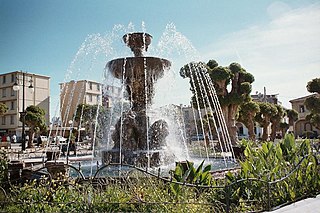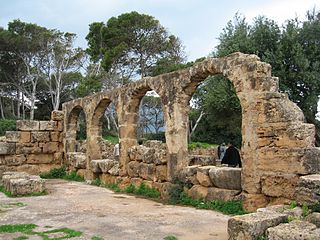
Castellum Dimmidi was a Roman castrum located in the south of the Mauretania Caesariensis [1]
Contents
It is the modern algerian city of Messaâd.

Castellum Dimmidi was a Roman castrum located in the south of the Mauretania Caesariensis [1]
It is the modern algerian city of Messaâd.
As the Castellum (castle) implies, the settlement was a fortress near the Fossatum Africae, the southern border of the province of Numidia. It was a prosperous village and hosted a Roman garrison (of the "III Legio Augusta") from roughly 198 to 240 AD. [2]
It was located about 290 km (180 mi) south of Algiers (then called Icosium), at the border of the Sahara desert. [3] During the second century of the Roman period it was created under emperor Septimius Severus. [4] It is unclear if the second part of the name, Dimmidi, was a native name transliterated into Latin, or a new name given by the Romans.
In 198 AD the legate propraetor of the Third Legion had sent legionaries there, supported by Pannonian cavalry and under the command of Flavius Superus. The installation of a permanent camp undoubtedly dates to that time. The camp was maintained until about 238 AD, the date of the temporary disbanding of the Third Legion.Excavations have revealed a part of the rampart which protected the soldiers' quarters. The wall was irregular in plan. Today very little can be seen on the site since the excavations were not continued and no attempt was made to consolidate the remains. The inscriptions also have almost all disappeared. They have been published and permit the reconstruction of certain aspects of the life of the camp. About 100 men relieved one another there; they were legionaries and later, after Alexander Severus, Palmyrans.The inscriptions and the paintings (now deposited at the Algiers Museum) give an idea of the soldiers' religious life as it pertained to official and Palmyrene cults.P. Fevrier [5]
Probably -according to Philippe Leveau- the village survived the removal of the legionaries' castrum for another century and half, until the end of the fourth century. [6]
Only in 1856 the French Reboud found some remnants, that were fully studied only in 1939-1941 by Gilbert-Charles Picard. [7]

Lambaesis (Lambæsis), Lambaisis or Lambaesa, is a Roman archaeological site in Algeria, 11 km (7 mi) southeast of Batna and 27 km (17 mi) west of Timgad, located next to the modern village of Tazoult. The former bishopric is also a Latin Catholic titular bishopric.

Mauretania Caesariensis was a Roman province located in what is now Algeria in the Maghreb. The full name refers to its capital Caesarea Mauretaniae.

Cherchell is a town on Algeria's Mediterranean coast, 89 kilometers (55 mi) west of Algiers. It is the seat of Cherchell District in Tipaza Province. Under the names Iol and Caesarea, it was formerly a Roman colony and the capital of the kingdoms of Numidia and Mauretania.

Legio VI Ferrata was a legion of the Imperial Roman army. In 30 BC it became part of the emperor Augustus's standing army. It continued in existence into the 4th century. A Legio VI fought in the Roman Republican civil wars of the 40s and 30s BC. Sent to garrison the province of Judaea, it remained there for the next two centuries.

Tipasa, sometimes distinguished as Tipasa in Mauretania, was a colonia in the Roman province Mauretania Caesariensis, nowadays called Tipaza, and located in coastal central Algeria. Since 2002, it has been declared by UNESCO a World Heritage Site.

Tamuda was an ancient Berber city and military camp in Mauretania Tingitana. It is located 6 km west of the present-day Tetouan in northern Morocco. Stone ruins from the site are found by the south bank of the Martil Valley. It was considered a city in accordance with the rules of urbanization of the time.

Zuccabar or Zucchabar was an ancient town in the Roman province of Mauretania Caesariensis. It is located in present-day Miliana, Algeria.

Icosium was a Berber city that was part of Numidia which became an important Roman colony: in Icosium were settled many Roman colonists since Augustus times and there was an early medieval bishopric in what is now the casbah area of actual Algiers.

Altava was an ancient Romano-Berber city in present-day Algeria. It served as the capital of the ancient Berber Kingdom of Altava. During the French presence, the town was called Lamoriciere. It was situated in the modern Ouled Mimoun near Tlemcen.

Caesarea in Mauretania was a Roman colony in Roman-Berber North Africa. It was the capital of Mauretania Caesariensis and is now called Cherchell, in modern Algeria. In the present time is Caesarea used as a titular see for Catholic and Eastern Orthodox bishops.

Gemellae was a Roman fort and associated camp on the fringe of the Sahara Desert in what is today part of Algeria. It is now an archaeological site, 25 km south and 19 km west of Biskra, and 5 km southwest of the present-day village of M'Lili with which it probably shares an original Berber name. It was connected by military Roman road to Castellum Dimmidi and Capsa.

Auzia was a Roman-Berber colonia in present-day Sour El-Ghozlane, Algeria. The area was located around 150 km south-east of Algiers, in the ancient province of Mauretania Caesariensis.

Rapidum was a Roman settlement and fort located in Mauretania Caesariensis, nearly 100 km south of Icosium (Algiers).

Castellum Tingitii, also called Castellum Tingitanum, was a Roman colonia in Mauretania Caesariensis, and corresponds to present-day Chlef in Algeria.

Roman colonies in Berber Africa are the cities—populated by Roman citizens—created in Berber North Africa by the Roman Empire, mainly in the period between the reigns of Augustus and Trajan. These colonies were created in the area—now called Tamazgha by the Berbers—located between Morocco and Libyan Tripolitania.
The gens Oclatia was an obscure plebeian family at ancient Rome. The only member known to have held any magistracy is Gaius Oclatius Modestus, quaestor in the first half of the second century, but many Oclatii are known from inscriptions.

Cohors Breucorum was an important Roman castrum located in western Mauretania Caesariensis.

The Limes Mauretaniae was a portion of a 4,000-kilometre (2,500 mi) Roman fortified border (limes) in Africa approximately 100 kilometres (62 mi) south of the modern day Algiers.

The Mauro-Roman Kingdom was an independent Christian Berber kingdom centred in the capital city of Altava which controlled much of the ancient Roman province of Mauretania Caesariensis. The kingdom was first formed in the fifth century as Roman control over the province weakened and Imperial resources had to be concentrated elsewhere, notably in defending the Italian Peninsula itself from invading Germanic tribes.
The gens Silicia, possibly the same as Selicia, was an obscure plebeian family at ancient Rome. Hardly any members of this gens are mentioned in history, but a number are known from inscriptions, many of them from Roman Africa.